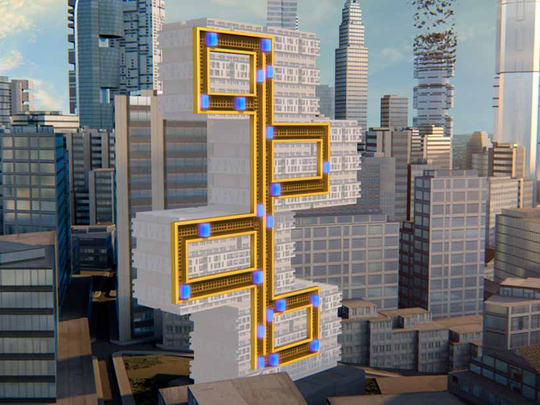
Getting to the moon couldn’t be easier. All you have to do is step into the right elevator and press the button that says moon… However, the fine print here is that the elevator exists only in virtual reality, and you will need to don a VR headset to go on this ride. At Gamescom 2017, the world’s largest gaming convention, a star attraction was the VR title, Elevator... to the Moon!. Released by German gaming peripherals brand Roccat, the game tasks you with the job of building an elevator all the way to the moon.
While you might be able to pull off this feat in the game, is the elevator idea too absurd to be taken seriously? Well, consider this — in 2017, the second prize in the Grade 12 category of the Nasa Ames Space Settlement Contest was bagged by Sai Kiran P., an 18-year-old from Chennai, India, who presented a proposal for elevators powered by centripetal acceleration. Apparently, the technology will be able to lift elevators to 40,0000km and transport humans or cargo to the moon. Moreover, such space elevators will work out cheaper than using rockets to send stuff up there.
We may have to wait a few decades — perhaps even a century — to hop over to the moon in an elevator. But till then, with the latest in elevator tech, we can reach for the clouds. Especially in the Middle East, where buildings are soaring to unbelievable heights. Nicolas Alchal, Managing Director — Kone UAE, Oman and Bahrain, notes that one of the biggest challenges in this region is that it has among the highest density of high-rise buildings in the world. “Developers and consultants want to push the limits and we help them do that. It’s a challenge but also an opportunity to develop innovative solutions to achieve the impossible,” he says.
Alain Chemaly, CEO, thyssenkrupp Elevator Middle East, agrees. “Customers in this region tend to be early adopters of new technologies the and latest innovations in their quest to be number one in different areas.”
No strings attached
A key part of the high-tech plan for transporting people higher than ever before involves getting rid of the heavy steel rope, which has been a staple fixture of elevators for more than 100 years. Alchal explains these ropes have many disadvantages, including high energy consumption, rope stretch, large moving masses, and downtime caused by building sway. He points to Kone’s new UltraRope technology, which will enable future elevators to reach heights up to 1,000 metres. The rope has a carbon fibre core embedded in epoxy, and is apparently around 90 per cent lighter than the existing industry standard. It also vibrates less, and the elevators can keep working even when very tall constructions are swaying in windy conditions.
Elsewhere, thyssenkrupp has taken a different approach with its upcoming Multi elevator system — the company solved the rope challenge by getting rid of the rope. Chemaly says that Multi is the world’s first ropefree elevator system that is set to revolutionise tall building construction and end the 160- year reign of rope-dependent elevators. Moreover, this technology enables the elevator to move not only up and down, but also sideways — imagine being able to travel from one building to another without changing elevators.
Chemaly explains that Multi harnesses the power of linear motor technology, to move multiple cars in a single shaft — both vertically and horizontally — resulting in significantly reduced waiting times, smaller footprint, much greater capacity, substantially reduced weight and mass and no more building height and shape design constraints. The first Multi will be installed at OVG Real Estate’s new East Side Tower in Berlin.
View of the future
Mitsubishi Electric describes it as a “vision of the future of modern architectural space design” that delivers an expansive panoramic view for users, while transforming its surrounding into an unprecedented architectural masterpiece. Hyperbole aside, spiral escalators, which move in a curve instead of a straight line, have a key advantage over standard escalators — they use space efficiently.
The most famous example of this tech can be experienced at the New World Daimaru Department Store in Shanghai, — reaching seven floors up, it is also the world’s largest spiral escalator. And, though still a concept, the Helixator promises to make even more efficient use of space — looking a bit like DNA strands, it uses monorail technology that allows for the construction of escalators in any given geometry, including straight, curved and helical.
Walking on air
Walkways too are gearing up for a crowded future. Besides, they are getting faster and cutting down on connecting time at airports and metros. A prominent example is thyssenkrupp’s Accel, which has taken the technology used in magnetic levitation trains and applied it to walkways. Chemaly says it provides an efficient solution to the global challenges of urbanisation, and points to thyssenkrupp’s first-generation Accel express walkway, installed at the Toronto Pearson International Airport.
“Passengers step on at 0.65 metres a second and smoothly accelerate up to 2 metres a second. By doing so, thyssenkrupp has created a product as safe and easy to use as a conventional moving walk, while still three times faster,” he says, adding that at airport terminals, Accel reduces connection times between gates by up to 70 per cent. It also alleviates traffic congestion by improving access to metro stations and attracting up to 30 per cent additional passengers.












